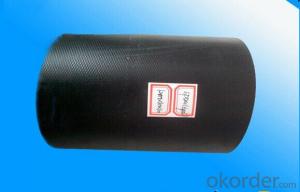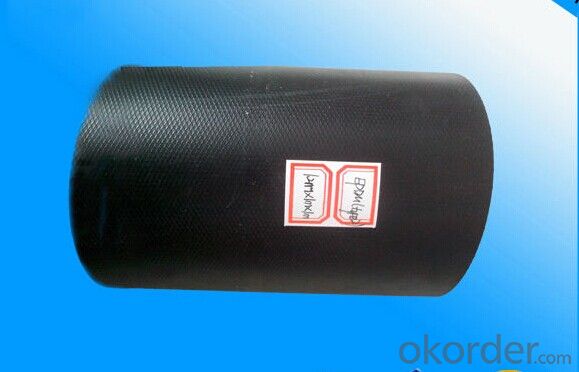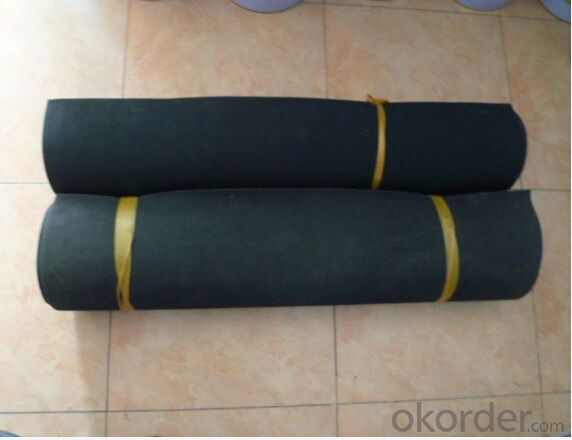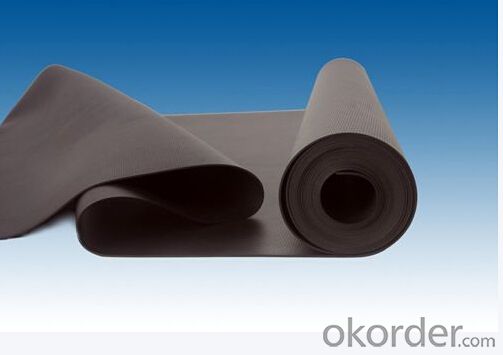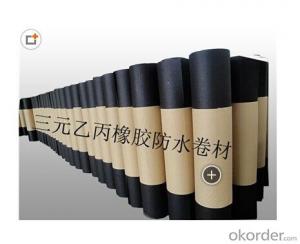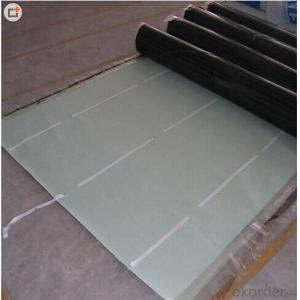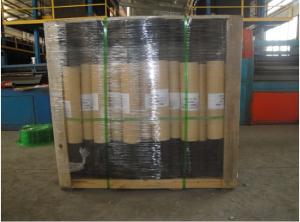EPDM Rubber Roof Waterproof Membrane with High Quality
- Loading Port:
- Qingdao
- Payment Terms:
- TT OR LC
- Min Order Qty:
- 2000 m²
- Supply Capability:
- 10000 m²/month
OKorder Service Pledge
OKorder Financial Service
You Might Also Like
Epdm Rubber Roof in Rolls Membrane
Characteristics:
Good synthesis aging resistance;ozone resistacne;ultravoilet resistance;chemical resistance;corrosion resistance.High tensile strength and good elasticity;endured the puncture-resistant and cracking resistance.
Specification:
With: 1m-4m
Length: 20m
Thickness:1.2mm;1.5mm;2mm
Packing:
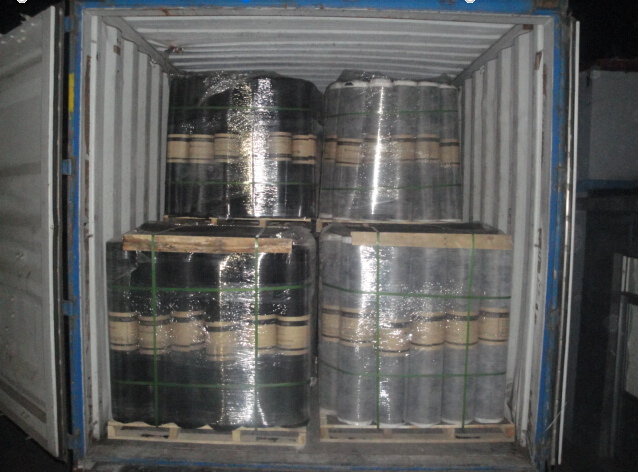
Technical Data:
Technical Capacity Index(Ref to Chinese Standard GB18173.1-2006) | ||
EPDM Rubber Waterproof Membrane | ||
No. | Item | Index |
1
|
Water tightness |
≥0.3 Mpa,No leakage
|
2 | Tensile strength | ≥7.5Mpa |
3 | Elongation at break% | ≥450 |
4 | Tearing strength,KG/m | ≥25 |
5 | Brittleness point | ≤-40 |
Application
Widely used in roofs, basement, toilet ,swimming pool, and all kinds of industry and civil building waterproofing, reservoir, vivicism, bridge, underground, tunnel and dam waterproofing ,especially to the keystone waterproofing projects which is durability, high corrosion resistance and easy deformation
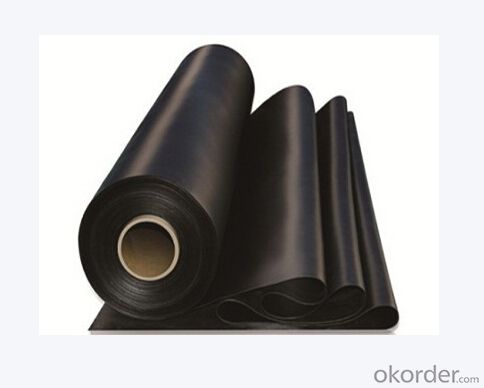

- Q: How does a waterproofing membrane handle differential settlement?
- A waterproofing membrane is designed to provide a barrier against water infiltration and protect the underlying structure from moisture damage. However, when it comes to handling differential settlement, the performance of the waterproofing membrane can be affected. Differential settlement refers to the uneven settling of the ground or the building foundation, which can lead to variations in the height or level of different parts of the structure. This can create stress and movement in the building, potentially affecting the waterproofing membrane. To address differential settlement, waterproofing membranes are typically designed to be flexible and able to accommodate minor movements without compromising their effectiveness. They are often made from materials such as modified bitumen, polyurethane, or rubberized asphalt, which have inherent elasticity and can stretch or contract to some extent. In cases of minor differential settlement, where the movement is within the tolerances of the membrane, it can adjust and remain intact, maintaining its waterproofing capabilities. However, if the settlement is significant or beyond the membrane's capacity to flex, it may cause the membrane to crack or tear, leading to potential water leakage. To mitigate the impact of differential settlement, additional measures may be taken during the installation of the waterproofing membrane. This could include incorporating stress relieving elements such as expansion joints or using specialized installation techniques that allow for movement. These measures help to distribute the stress caused by settlement and reduce the strain on the waterproofing membrane. It is important to note that while waterproofing membranes are designed to handle some level of differential settlement, they are not a solution for structural issues or significant settlement problems. In cases of severe settlement, it is crucial to address the underlying cause of the settlement and potentially involve a structural engineer to determine the appropriate remediation measures. In conclusion, a waterproofing membrane can handle differential settlement to a certain extent by being flexible and accommodating minor movements. However, it is essential to consider the severity of settlement and implement additional measures during installation to ensure the long-term effectiveness of the waterproofing system.
- Q: Are there any specific considerations for installing a waterproofing membrane on concrete surfaces?
- Installing a waterproofing membrane on concrete surfaces requires careful attention to several specific considerations. Firstly, it is crucial to thoroughly clean the concrete surface and remove any loose materials, oil, grease, or contaminants that could hinder the adhesion of the membrane. Failure to do so may compromise the effectiveness of the waterproofing. Secondly, it is of utmost importance to inspect the concrete surface for cracks, spalling, or other types of damage. Prior to installing the waterproofing membrane, these defects must be repaired to prevent water from penetrating through the membrane and compromising its ability to protect the concrete. Moreover, the selection of the appropriate type of waterproofing membrane is essential. There are various options available, such as sheet membranes, liquid-applied membranes, and cementitious coatings. Each type has different application methods, durability, flexibility, and resistance to substances. Therefore, it is crucial to choose the membrane that best suits the specific concrete surface and its intended use. In addition, the installation process should strictly adhere to the manufacturer's instructions. This includes applying the membrane at the recommended thickness, ensuring proper overlap and adhesion of the seams, and using any recommended primers or adhesives. Lastly, long-term maintenance and durability should be taken into consideration. Regular inspections, maintenance, and repairs are necessary to ensure the membrane remains intact and effective in preventing water penetration.
- Q: Is a waterproofing membrane compatible with different types of roofing materials?
- Yes, a waterproofing membrane is compatible with different types of roofing materials. A waterproofing membrane is a versatile solution that can be used on various roofing materials such as asphalt shingles, metal roofs, concrete roofs, and even flat roofs. The membrane is designed to provide a barrier against water penetration, regardless of the type of roofing material. It can be applied directly on the surface of the roof or as an underlayment before installing the roofing material. This compatibility ensures that the waterproofing membrane can be used effectively to protect and extend the lifespan of different types of roofs.
- Q: Are waterproofing membranes resistant to hydrochloric acid?
- Yes, waterproofing membranes are generally resistant to hydrochloric acid. These membranes are designed to provide a barrier against water and other liquids, and they are often made from materials such as PVC, EPDM, or TPO, which have excellent chemical resistance properties. Hydrochloric acid is a strong acid commonly used in industrial applications, and it can cause corrosion and damage to many materials. However, waterproofing membranes are specifically engineered to withstand harsh chemicals and protect the underlying structure from water intrusion. As a result, they are typically able to resist the corrosive effects of hydrochloric acid and maintain their integrity and waterproofing properties. It is important to note that the extent of resistance may vary depending on the specific type and quality of the waterproofing membrane, so it is advisable to consult the manufacturer's guidelines and specifications for accurate information on the acid resistance of a particular product.
- Q: Can a waterproofing membrane be used for theme parks or amusement centers?
- Absolutely, theme parks and amusement centers can certainly benefit from the use of a waterproofing membrane. These venues often feature a variety of water-focused attractions like water slides, splash pads, and swimming pools. In order to guarantee the safety and durability of these facilities, it is crucial to have a reliable waterproofing system in place. By acting as a protective barrier against water infiltration, a waterproofing membrane prevents any potential harm to the underlying structures and eliminates the risk of water leakage. This ensures that water remains confined to its designated areas, minimizing the likelihood of accidents or structural problems. Moreover, a waterproofing membrane can also be employed in walkways and outdoor seating areas, shielding them from water damage caused by rainfall or other water-related activities within the park. Overall, incorporating a waterproofing membrane into theme parks or amusement centers is a wise investment that guarantees the long-lasting functionality, safety, and resilience of the water-based attractions and other park structures.
- Q: Can a waterproofing membrane be used for interior applications?
- Yes, a waterproofing membrane can be used for interior applications. It is commonly used in bathrooms, kitchens, basements, and other areas where moisture or water damage is a concern. The membrane helps prevent water penetration and protects the underlying structure from potential damage.
- Q: Are there different waterproofing membrane options for above-ground and below-ground applications?
- Yes, there are different waterproofing membrane options available for above-ground and below-ground applications. Above-ground applications typically involve waterproofing structures such as roofs, balconies, or walls. For these applications, commonly used waterproofing membrane options include liquid-applied membranes, sheet membranes, and polyurethane membranes. These membranes are designed to withstand exposure to weather elements such as UV rays, temperature changes, and foot traffic. On the other hand, below-ground applications involve waterproofing structures like basements, foundations, or tunnels. Below-ground waterproofing membranes are specifically designed to withstand hydrostatic pressure from the surrounding soil and groundwater. These membranes are typically thicker and more durable than above-ground membranes. Commonly used below-ground waterproofing options include bituminous membranes, bentonite clay membranes, and composite membranes. It is important to choose the right waterproofing membrane for each specific application as the requirements and challenges can vary. Consulting with a waterproofing professional or engineer can help determine the most suitable membrane option for both above-ground and below-ground applications.
- Q: Can waterproofing membranes be used on loading docks?
- Yes, waterproofing membranes can be used on loading docks. Waterproofing membranes are commonly used in various construction projects to prevent water infiltration and protect the underlying structure. Since loading docks are exposed to rain, snow, and other weather conditions, applying a waterproofing membrane can help to keep the dock area dry and prevent water damage.
- Q: Can waterproofing membranes be used on bridge decks?
- Yes, waterproofing membranes can be used on bridge decks. Bridge decks are constantly exposed to harsh weather conditions, including rain, snow, and freeze-thaw cycles, which can lead to the deterioration of the concrete and steel reinforcement. Waterproofing membranes are designed to prevent water infiltration and protect the bridge deck from moisture-related damage. These membranes are typically made of flexible materials such as bitumen, PVC, or EPDM rubber, and they are applied directly onto the bridge deck surface. The waterproofing membrane acts as a barrier, preventing water from seeping into the concrete and causing corrosion of the reinforcement. It also helps to reduce the formation of cracks and extends the service life of the bridge deck. Additionally, waterproofing membranes can be combined with other protective coatings or systems to enhance their effectiveness and durability. Overall, the use of waterproofing membranes on bridge decks is a common and effective method to ensure the long-term integrity and functionality of the structure.
- Q: How does a waterproofing membrane handle settlement of adjacent structures?
- A waterproofing membrane can handle settlement of adjacent structures by being flexible and able to accommodate movement. It is designed to withstand and adapt to shifts in the surrounding structures without compromising its integrity or waterproofing capabilities.
Send your message to us
EPDM Rubber Roof Waterproof Membrane with High Quality
- Loading Port:
- Qingdao
- Payment Terms:
- TT OR LC
- Min Order Qty:
- 2000 m²
- Supply Capability:
- 10000 m²/month
OKorder Service Pledge
OKorder Financial Service
Similar products
Hot products
Hot Searches
Related keywords
